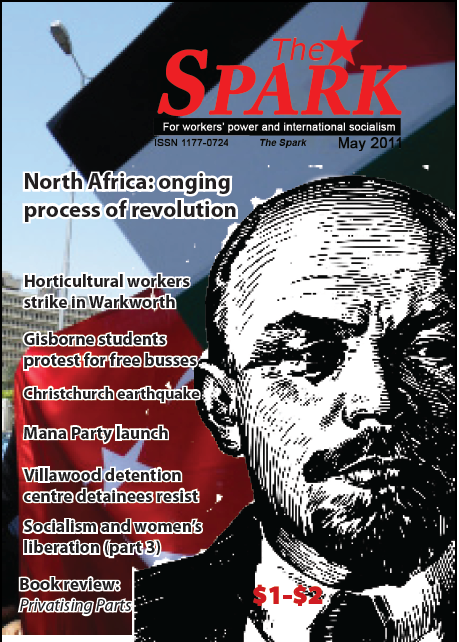This article by Jared Phillips will appear in the June 2011 issue of The Spark
This year New Zealand electors will vote in a national referendum, held as part of the general elections, asking them firstly to indicate whether they want to change from MMP, and secondly to indicate their preferred electoral system. The other options are First Past the Post (FPP), Preferential Voting (PV), Single Transferable Vote (STV), and Supplementary Member (SM). If a majority votes in favour of retaining MMP that decision will be binding. However, if a majority votes against retaining MMP, there will be a further referendum in 2014 whereby electors will decide between MMP and whichever alternative procedure gains the most support in the 2011 referendum. If a new system is selected in 2014 it will come into effect at the 2017 election.

Real advanced democracy can only be imposed and administered by the majority of working people through a workers‘ government. In the current period though, in which the working class has clearly not yet recovered organisationally or politically from the onslaught of neo-liberalism, it is important to ensure that the electoral system offering the most democratic electoral procedure prevails. From this point of view it is in the best interests of the working people and oppressed groups to retain MMP.
Continue reading “Defend MMP in the 2011 referendum”
Review – No ordinary deal: Unmasking the Trans-Pacific Partnership free trade agreement
No Ordinary Deal: Unmasking the Trans-Pacific Partnership free trade agreement
Jane Kelsey (ed.)
Bridget Williams Books, 2010
Reviewed by Mike Kay, Auckland member of Workers Party and member of The Spark editorial board 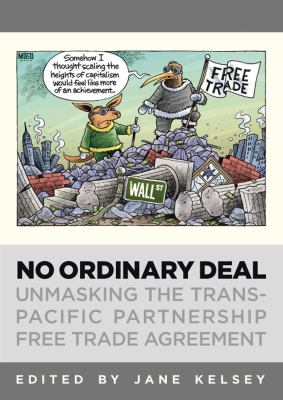
This collection of essays brings together a number of different perspectives on the Trans Pacific Partnership Agreement (TPPA), a Free Trade Agreement (FTA) currently being negotiated behind closed doors between Australia, Brunei Darussalam, Chile, New Zealand, Peru, Singapore and the United States. The policy framework is still largely neo-liberal, despite that economic model’s credibility taking a knock since the Global Financial Crisis.
Recent US-brokered trade deals, such as its December 2005 agreement with Peru, contain clauses to prohibit “expropriation and measures ‘tantamount to expropriation’, with the exception of a ‘public purpose’ (which carries a right to full compensation), and provides investors with due process protection and the right to receive a fair market value for property in the event of expropriation.” (p.74) This could have far-reaching consequences for any future socialist or progressive government.
But will the TPPA lead to a more liberal immigration policy with respect to the US’s TPP partners? Lori Wallach and Todd Tucker comment: “on a bipartisan basis, leaders of the congressional committee that sets immigration policy… have repeatedly insisted that no future trade pacts provisions may contain visa or other immigration policies. A TPPA with immigration provision would be dead on arrival in Congress.” (p.67) Continue reading “Review – No ordinary deal: Unmasking the Trans-Pacific Partnership free trade agreement”
Book review: Privatising Parts

Privatising parts
Richard Meros
Lawrence and Gibson 2011
Reviewed by Joel Cosgrove, Workers Party Wellington Branch
“Who better than students to teach teachers what students ought to be taught?”, so asks Richard Meros in his new fiction Privatising Parts. Quite simply this is a beautifully crafted piece of satire. On the surface this is a stinging critique of the far-right dwellers floating far out in the political stratosphere, think Muriel Newman, Roger Kerr etc. But this is not just a lampooning of the free-market logic taken to its extreme, it’s a satire of the underlying free-market logic itself.
For those unfamiliar with the work of Meros, he is the author of a number of independently produced books (so independent, that he takes part in the printing and binding himself). On the Conditions and Possibilities of Helen Clark Taking Me as Her Young Lover, and Beggars and Choosers: The Complete Written Correspondence between Creative New Zealand and Richard Meros volume one are amongst a slew of self-published titles. Continue reading “Book review: Privatising Parts”
Hamilton – North Africa/Middle-East solidarity meeting report

Tonight a small audience of twelve people bore mid-week stormy weather and attended a meeting organised by Hamilton Left Initiative which called for solidarity with the ongoing struggles in North Africa and the Middle-East.
The first speaker was Cameron Harper, a Waikato University student, who presented a historical background to the uprisings. This set the tone for more detailed analysis by two guest speakers and Workers Party member Josh Glue.
Harper was followed by Egyptian speaker Maher Elbohouty. A lecturer and PhD student in engineering, he provided an interesting eye-witness account of the revolution in Egypt that included photos as well as other footage. Elbohouty gave what he jokingly called ‘my own analysis’ of the upheaval in which – amongst other things – he pointed out the role of the internet and Facebook in spreading the rebellion and also the sympathy of the masses with the plight of Palestinian people. He also emphasised the role and involvement of women and illustrated this with pictures of women in both traditional and non-traditional wear.
Mohammad Tellawey is a Palestinian who works as a medical doctor in Hamilton. The theme of his presentation was the definition of terrorism and state terrorism. He began by discussing the definition of the word terrorism and in particular he outlined definitions as according to UN conventions and then drew attention to how the actions of some states meet those definitions. With reference to the Israel Defence Force’s 2009 assault on Gaza he overviewed Israel’s behaviour and commented that terrorism can be partly defined in terms of the questions ‘Are the victims civilian or army?’, ‘What was the method?’, and ‘What was the aim?’. He also concluded that in his opinion as a doctor, the people in Gaza are under constant psychological stress from Israel’s military and economic actions against them.
Josh Glue was the final listed speaker of the evening. He focussed on the clear class aspects of the uprisings. First he gave emphasis to the self-immolation protest by graduate student Mohamed Bouazizi in Tunisia against government forces which would not allow him to make a living as a street vendor. Glue then went on to discuss the elements of working class and union action – including union formation – in Egypt. He spoke of the role of the secret police and how masses had attacked the offices of the secret police and seized documents pertaining to previous instances of torture committed against pro- democracy activists. Finally Glue posed why US intervention is negative in Libya and noted the real stress that the uprisings are placing on imperialism in the region.
Because of the relatively small turnout at the meeting the evening took shape more as an educational forum than as a broad public meeting. Afterwards there was time for closer discussion between audience and speakers, and those in attendance formed general agreement to build more local activity on such issues.
Hamilton meeting for solidarity with North Africa / Middle East uprisings
Workers Party members have been involved in organising this meeting which will include a summary of the class aspects of the uprisings, an eye witness account – with unpublished photos from Egypt – by a post-gradaute student at Waikato University, and a presentation with a focus on implications for Palestinian liberation given by the Hamilton organiser of the PFLP solidarity campaign.
Read the May issue of The Spark here
Campaign launch of the Mana Party
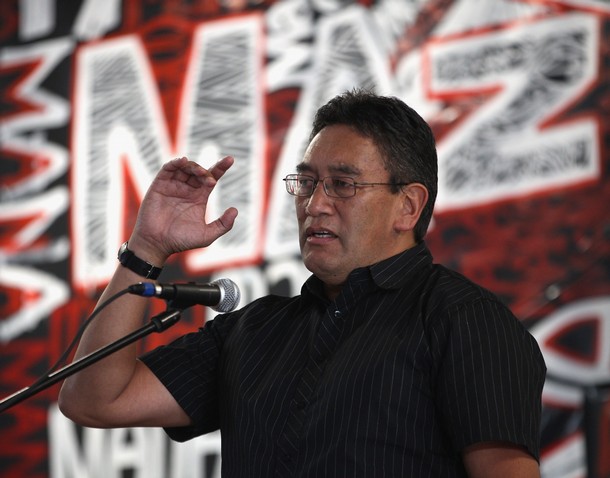
By Mike Kay (Workers Party, Auckland, and editorial board of The Spark)
The meeting hall at Mahurehure Marae in Auckland was packed to overflowing with activists keen to hear Hone Harawira launch the new Mana Party yesterday. The first approximately 1 1/2 hours of the meeting consisted of pōwhiri and speeches in te reo Māori. The following account describes the speeches in English that followed.
The hui opened with CTU Vice-President Māori Syd Keepa plainly stating: “Māori are poor,” and went on to highlight the need to speak out for Māori and the working class. He was followed by Professor Margret Mutu, who described Harawira as the only Te Tai Tokerau MP to have helped Ngāti Kahu, having given support to the occupation of Maheatai/ Taipa Pt. She also praised his support for those arrested in the October 15, 2007 police raids, and spoke of the need for a party to “protect us from the worst excesses of the rabid racism of Parliament.”
John Minto commented that much of the audience resembled a reunion of the 30th anniversary of the anti-Springbock tour movement. He said that while other Māori Party MPs had “melted into the warm embrace of John Key and the National party,” Hone Harawira was “a really good rock to build a new party on.” Miriama Pitama raised the call for a “movement of resistance.” Speaking of Harawira’s former colleagues, she said that it was clear that “the people are not with the Māori Party.”
Veronica Tawhai said “the system is not designed for Māori. Rangatahi [youth] don’t vote, because they can’t see the point… we need someone who will stand up in Parliament and say: ‘we do not recognise the sovereignty of this whare over Māori lives.’”
Former Green MP Nandor Tanczos described the Labour/ National duopoly of NZ politics as a choice between “tweedledum and tweedledumber,” with the small parties functioning merely as “clip-ons”. He talked of the need to change the system itself, with Mana potentially opening up a “third space” for a coalition of radical Māori, green and left parties. He also struck a note of caution that “you can’t just build a movement around the leadership of one person.”
Tanczos said it would be a “tradgedy” if the Mana and Māori Parties went to war with each other, adding that the new party represented a diversification of representation for Māori, in the same way that you would not expect all pākehā to be represented by a single party.
Te Tai Tokerau Electorate Chair Lisa McNabb emphasised how poverty, increases to GST and the cost of living had impacted on communities in the Far North. Annette Sykes observed the shift in mood since the Canterbury earthquake from an initial feeling of collective responsibility to help those afflicted, which more recently has retreated to an individualistic reaction against the better off having to pay a larger share of the rebuild. Sykes lamented that this creeping individualism had also affected Kaupapa Māori, and that Māori needed to reassert their belief in the collective.
Sykes drew comparisons between Harawira and Michael Savage (who established the welfare state due to his “love of the nation”) and Norman Kirk (whose government was supported by Pat Hohepa and Matiu Rata). She talked of the need to reclaim Aotearoa from “foreign ownership and privatisation.”
Hone Harawira opened his speech by saying Mana would “reject the politics of fear – and reject the politics of compromise… we deserve better than weak and accommodating leadership.” He referenced both the 1835 Declaration of Independence as well as the 1840 Treaty of Waitangi as principles to be affirmed. He insisted that Te Reo should be in the hands of the people, not bureaucracies and government departments.
He denounced the government for “driving people into poverty and penalising them for being poor.” He also criticised spending such as “$36 million being wasted on this bloody yacht race in San Francisco,” saying the money would be better spent on “emergency heating in the poorest suburbs of Christchurch that have been forgotten.”
Harawira talked of the need to stop the sale of state assets and provide people with affordable food, shelter and power – “simple shit,” as he put it. He affirmed the right to a “decent day’s pay for a decent day’s work”, and the need to “overturn the 90 days slave labour law.” Addressing unionists who were “still stuck on Labour,” he reminded them that union membership went down over the period of the last Labour-led government.
Harawira proposed a 1% financial transactions tax, or “Hone Heke Tax”, that would “chop down GST.” He stated the most important aim of the movement was to “reclaim the mana of our people” – not just Māori, but workers and “our Pacific Island cousins, who continue to be brought over here as cheap labour to be exploited and sent home at the end of the season.” He announced his intention to call a by-election in Te Tai Tokerau, to seek a mandate for the Mana Party, so that he may return to Parliament as its first MP.
Matt McCarten wrapped up the hui by commenting that “the right wing had unfinished business from Rogenomics,” and that it was “the people in this room that will lead the fight against it,” concluding that “after 35 years of trying, for the first time I feel we’re finally getting it right.” He encouraged the audience to sign up with Mana so that it could become a registered party. When the meeting ended, they did so in droves.
Workers republic? Yes, Governor-General? Nah

Mike Kay, Workers Party, Auckland
Buckingham Palace issued the following statement on 7 March: “The Queen, on the recommendation of the Prime Minister of New Zealand, has been pleased to approve the appointment of Lieutenant General Jeremiah Mateparae as the next Governor-General of New Zealand.”
The man chosen to replace Sir Anand Satyanand came as something of a surprise to the pundits and, reportedly, to Mataparae himself. He is the first soldier to hold the post for 40 years. Of the previous eight Governors-General, five have come from a legal background and another was an elderly former Prime Minister, Sir Keith Holyoake.
Some have questioned whether this is the “Paul Henry effect”, a reference to the disgraced broadcaster’s comment to John Key that the next Governor-General should be “a New Zealander who looks and sounds like a New Zealander”.
That may have weighed in the balance. But far more significantly, Mateparae’s appointment functions as a double whammy by the government: it strengthens the forces of both militarist nationalism and conservative Māoridom. This follows on, in lockstep formation, from the spectacle of Victoria Cross recipient Col. Willie Apiata being paraded across Marae under the previous Labour led government.
The Governor-General is the representative of the Queen in Aotearoa. Many people these days see the monarchy as a harmless bit of fun, just another aspect of trash mag celeb culture. The day to day role of both the Queen and Governor-General is indeed largely ceremonial. Yet the holder of the post of Governor-General possesses major reserve powers. Although rarely used, these include the power to dismiss a Prime Minister, dissolve parliament and call new elections, refuse to pass legislation into law and grant a pardon to someone who may have been wrongly convicted.
One of the most infamous examples of these reserve powers was enacted in 1975 when the Australian Governor-General dismissed a left-leaning Labor government headed by Gough Whitlam, and installed Liberal Party leader Malcolm Fraser as caretaker PM.
The post of Governor-General is an outdated vestige of feudalism. It needs to be abolished as an elementary step towards a workers republic.
Gisborne school students organise 2000-strong demonstration for free busses
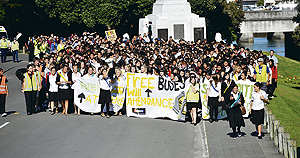
Jared Phillips, The Spark coordinating editor
“That a group of Girls’ High students researched the problem and approached the Ministry of Education last month, with a supporting submission from the city’s high school principals, not only shows great initiative but puts the best face to this issue. Some will quibble with the fact today’s march, which started at 9am, cut into valuable school time. The direct action to try and address an historic injustice is to be commended, though. They certainly have our attention” – Jeremy Muir, Editor, The Gisborne Herald.
On Wednesday April 13 up to 2000 high school students and their supporters (with some reports of more) made a Hikoi (demonstration march) through the main streets of Gisborne, a city on the East Coast of New Zealand’s North Island. They were raising a demand for free school busses for students who live in the Kaiti suburbs.
Kaiti comprises much of the eastern side of Gisborne and all four of the city’s high schools are located in the western side. When family budgets can’t meet travel costs, students from Kaiti have to walk up to 5 kilometres to get to school. This is often the case as the Kaiti suburbs constitute the majority of the poorer suburbs of Gisborne. The suburbs are literally on the other side of the bridge and populated predominantly by working class people including unemployed.
Protest organised primarily by school students
It was reported in a Gisborne Herald editorial (6/4/11) that the hikoi was initiated by Gisborne Girls High School students, in a Year 12 health class, who had carried out a research project which found that non-attendance amongst students who live in Kaiti grew in the period leading into winter because of transport issues. As well as affordability other issues were identified such as problems with minimal shelter at bus stops and bus overcrowding.
From there the Girls High students combined with students from Lytton and Boys’ High and won support for the protest from teachers and other adults. The students indicated that they were highlighting “a serious social justice issue” in Gisborne (Gisborne Herald, 6/4/11). Heather Gorrie, principal at Girls High School, said that the issue impacts on more than 700 students every year.
With a majority of the demonstration being comprised of school students, an estimated two thousand people attended. The Gisborne Herald (14/4/11) reported a turnout of more than two thousand and Newstalk ZB (13/4/11) reported one thousand.
No account of ability to pay
Income in Kaiti is well below national averages. The national median income in June 2010 was NZ$27,508 from people of all sources of income. At the same time the national median income for wage and salary earners was NZ$41,444 (Statistics New Zealand, Income Survey June 2010). The annual median income in Kaiti is just NZ$19,525 and in Outer Kaiti (which is furthest from the high schools) the median income is NZ$16,300 (The Gisborne Herald, 13/4/11).
Adding to that broad picture of inequality, families who live in the idyllic beachside suburbs of Makorori and Wainui – which are predominantly middle and upper class areas – can without cost send their children to the Gisborne high schools on busses that pass straight through Kaiti. The editor of The Gisborne Herald (6/4/11), wrote “Farcically, we have students from upmarket ‘rural’ Wainui riding free to school through low socio-economic Kaiti, where families pay $10 per week for each child to attend high-school by bus”.
The Wainui area, as well as the Makorori area is outside of the 4.8 kilometre range from Gisborne’s high schools, allowing school students in the area to be considered rural in accordance with the Ministry of Education’s criteria. Students who live within 4.8 kilometres of a secondary school also have fully subsidised transport. It is because the Kaiti students live in an urban area outside of a 4.8 kilometre radius that their parents and caregivers are required to pay $1 per child for each trip to and from school.
The action and the government response
The hikoi started at 9am at Waikirikiri primary school in Outer Kaiti and went on to Te Wharau primary school. At both schools there was strong support given from teachers and parents, as it is their children who will soon be amongst the more than 700 pupils affected by the issue each year.
On occasion the march brought traffic to a stop. A small group from the march attended a meeting at the offices of the Gisborne City Council. One councillor asked them why they didn’t bike to school like when he was a child and they responded that bikes were often too expensive and traffic has changed and there are more people getting hurt on bikes (biking to school has actually become a thing of the past, the bike sheds at many schools have been taken down for some years).
The marchers shouted various chants including ‘Free Busses – Up Attendance!’ and ended the protest at Girls’ High at around 12 noon.
The Minister of Education, Anne Tolley, who is also National’s MP for Gisborne is refusing to make an exemption to the 4.8 kilometre rule for the Kaiti students. Local people argue that there should be an exemption because Gisborne is the only city in which all of the high schools are located on one side of the city. Tolley resorted to snide comments and rejected the link between bad weather and truancy, noting that rain and the distance between Kaiti and the high schools had been present for decades. In other words she doesn’t accept a historic injustice, one that has been present for thirty years, and seeks to maintain the status quo whereby the poor have to walk long distances in bad weather to get to school.
Tolley said that “There is no equity issue other than distance”. School students, teachers, principals, parents and mainstream news editors think different. The whole issue highlights not only inequality, but the deceptiveness of the type of democracy we live in; a broad community wants something to change but the government tries to ignore the community and ridicule it. Now it’s up to the students, parents, and anyone who supports local democracy to escalate the issue.
The Spark reformatted, appeal for new subscriptions
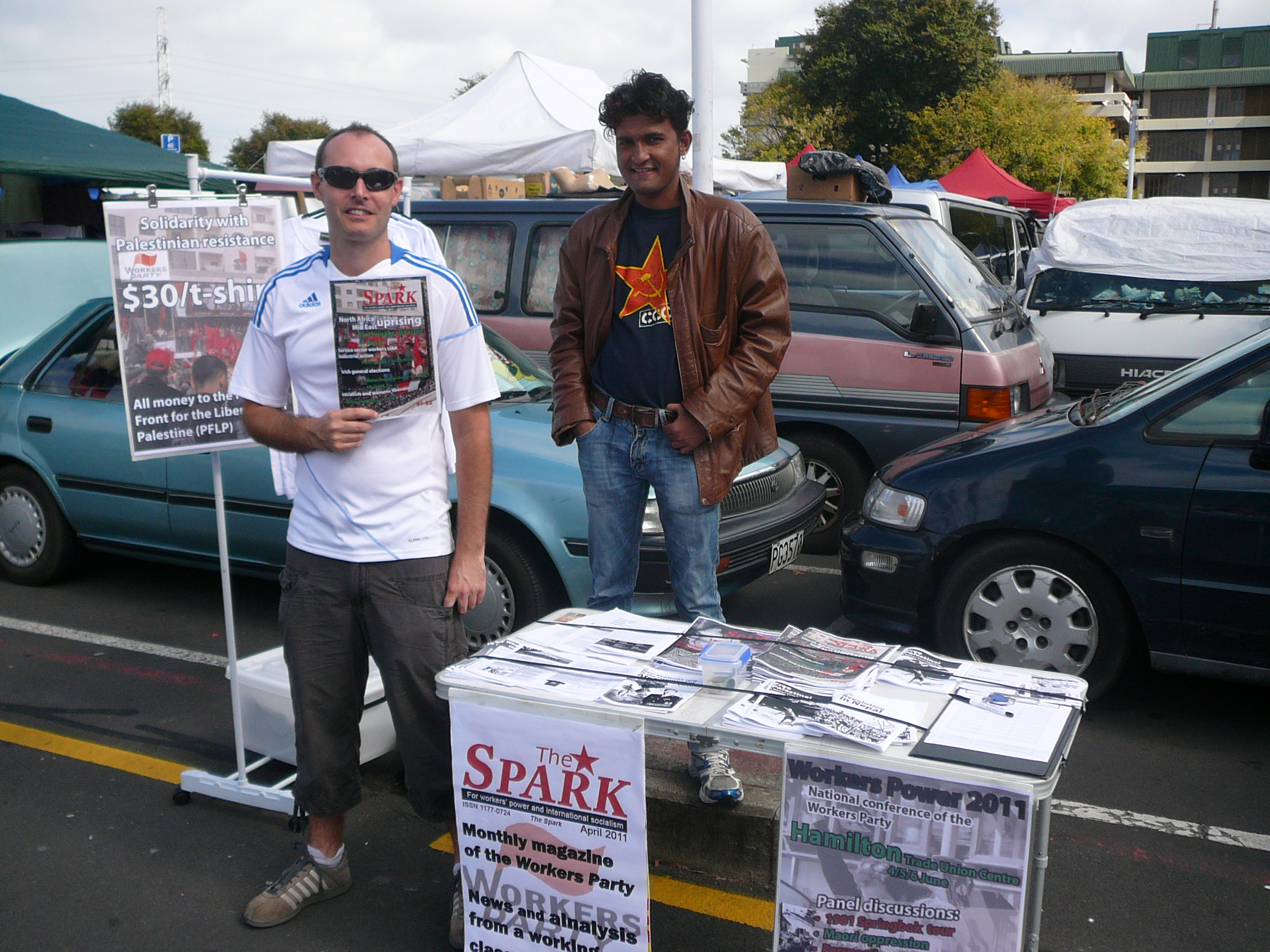
We are pleased that we can now continue to circulate the only far-left monthly magazine in New Zealand in an updated and attractive format. We intend to continue building circulation and developing a new subscription base amongst advanced elements of the working class and youth. You can read most articles online but subscribing to the paper allows for deeper reading, you get it every month, you can pass it on, and it’s a good way to further support the dissemination of Marxist ideas in New Zealand.
Included below are the editorials of the March and April 2011 issues along with the PDFs of the hard copies.
April 2011 Editorial and PDF
This issue begins with coverage of the Japan and Christchurch earthquakes. With regard to the very sad situation in Japan we put forward that capitalist social relations extenuate negative outcomes from natural disasters. In the March issue we published a bare facts analysis of the Christchurch earthquake, in this issue we are taking a more sociological look at some aspects of the recovery phase.
We are first-time publishing two articles on the upheaval in the Arab world, one is a major original article outlining the background to events written by John Edmundson, the other is a report on a public meeting on the issue, partially organised by Workers Party, which attracted 90 people.
Continuing from the March issue, this month’s issue of The Spark contains part two of three of a major piece on women’s liberation. Also continuing from last month is the second and final part of a new article reflecting on the 1951 waterfront lockout at its 60th anniversary. Margaret Jones, a subscriber to this magazine, sent us a photo of her father with waterfront workers leader Jock Barnes. Together they were standing by Margaret’s father’s truck which was loaded with a massive amount of food and supplies for the locked out workers. We think this may be the first time the photo has ever been published.
This year members of Unite Union have already been locked out at SkyCity Casino and at First Security. SFWU members were also amongst those locked out at the casino. That the bosses are locking-out in the service sector reveals the current level of confidence amongst employers. In both cases the lockouts were defeated by prompt and militant action. Please see this issue’s coverage of recent industrial disputes. As always, please consider subscribing and donating to The Spark. You can download the April issue of The Spark here April issue of The Spark
March 2011 Editorial and PDF
It’s only March and the year has already been defined politically both on the globe and in New Zealand. In North Africa we’ve witnessed massive uprisings of people standing up against undemocratic governments and against the agenda of major imperialist powers in the Middle East. In Christchurch we have seen the worst catastrophe ever to hit New Zealand. We’ll continue to report on both subjects.
Rosa Luxemburg and Jock Barnes appear on the front cover of this month’s issue. Sixty years ago Barnes was a workers’ leader of the 1951 waterfront lockout which we review in this issue. Luxemburg was a foremost theorist and working class revolutionary who – on the orders of the Social Democratic government in Germany – was executed in 1919. In this issue we publish a major piece on women’s oppression and liberation. Luxemburg was at the front of the fight for women’s liberation.
As is usual, we offer coverage of workers’ actions around the country. The actions being taken are particularly important as the government is about to enforce new anti-worker legislation from April 1st. We also have some coverage against a company which attempts to silence and discipline its employees for speaking out of synch with the company line. Thanks for buying The Spark, if you like this paper please subscribe!
Download the March issue of The Spark here March 2011 issue of The Spark
PDF versions of upcoming issues of The Spark will be posted upon publication.
To subscribe to The Spark please pay:
Within NZ $16.50 for one year (11 issues) or $33 for two years, or;
Rest of the world $20 for one year OR $40 for two years,
Send manual details and payments to The Spark, PO Box 10-282, Dominion Road, Auckland,
Send details and pay electronically email beckybroad80@hotmail.com with payment to 38-9002-0817250-01

